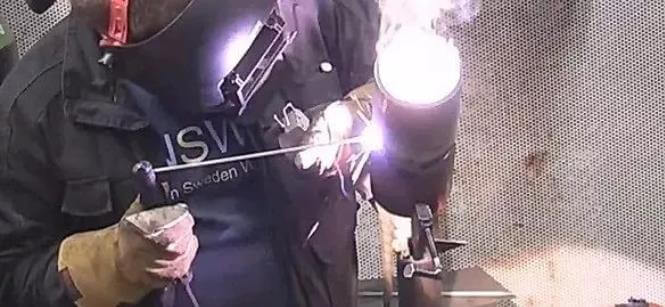
High carbon steel refers to a type of carbon steel with a carbon (c) content greater than 0.6%.
It is more prone to hardening compared to medium carbon steel and forms high carbon martensite, which is prone to cold crack formation.
The martensitic structure formed in the heat-affected zone of welding has hard and brittle properties, leading to a significant decrease in the plasticity and toughness of the joint. As a result, the weldability of high carbon steel is poor and a specialized welding process must be used to maintain joint performance.
Due to its poor weldability, high carbon steel is not commonly used in welding structures.
High carbon steel is mainly used in machine parts that require high hardness and wear resistance, such as rotating shafts, large gears and couplings.
To conserve steel and simplify processing technology, these machine parts are often joined by welding.
Heavy machinery manufacturing may also involve welding high-carbon steel parts.
When developing the welding process for high carbon steel components, it is important to thoroughly analyze possible welding defects and implement appropriate measures for the welding process.

1. Weldability of high carbon steel
1.1 Arc method
High-carbon steel is mainly used in structures that require high hardness and wear resistance, and is typically welded by electrode arc welding, brazing or submerged arc welding.
1.2 Construction materials
Welding high carbon steel does not necessarily require the joint and base metal to be of equal strength.
For electrode arc welding, low hydrogen electrodes are typically used, with strong desulfurization ability, low diffusible hydrogen content in the deposited metal, and good toughness.
If the strength of the weld metal and base metal is required, a low hydrogen electrode of the appropriate grade should be selected.
However, if the resistance of the weld metal and base metal is not required, an electrode with a low hydrogen content and a resistance level lower than that of the base metal should be selected.
It is important to avoid selecting an electrode with a higher resistance level than the base metal.
If preheating the base metal is not possible during welding, an austenitic stainless steel electrode can be used to prevent cold cracking in the heat-affected zone, resulting in an austenitic structure with good plasticity and crack resistance.
1.3 P roof repair
To limit the carbon content in the weld metal, the melting rate must be reduced. As a result, U- or V-shaped grooves are commonly used during welding. It is important to clean any oil and rust stains within 20mm on both sides of the groove.
1.4 Reheating
When welding with structural steel electrodes, preheating is necessary and must be performed before welding. The preheating temperature must be controlled within the range of 250°C to 350°C.
1.5 Interlayer treatment
In multilayer and multipass welding, the first pass is typically performed using a small diameter, low current electrode.
The workpiece is generally positioned in semi-vertical welding, or the welding rod is used to swing sideways, allowing the entire heat-affected zone of the base metal to be heated quickly, thus achieving the effects of preheating and heat preservation.
1.6 Weld heat treatment
Immediately after welding, the part must be placed in a heating oven and subjected to thermal insulation at 650°C for stress-relieved annealing.

2. High carbon steel welding defects and preventive measures
High carbon steel has a strong tendency to harden, making it susceptible to hot and cold cracking during welding.
2.1 Preventive measures for thermal cracks
(1) Control of the Chemical Composition of the Weld
It is important to strictly control the sulfur and phosphorus content and increase the manganese content appropriately to improve the weld structure and reduce segregation.
(2) Weld section shape control
The aspect ratio should be slightly higher to avoid segregation in the center of the weld.
(3) High Rigidity Welding
For welding with high stiffness, appropriate welding parameters, sequence and direction must be selected.
(4) Preheating and slow cooling measures
If necessary, preheating and slow cooling measures must be implemented to avoid hot cracking.
(5) Increase in Electrode Alkalinity or Flow
Increasing the alkalinity of the electrode or flux can reduce impurities in the weld and increase segregation.
2.2 Preventive measures (4 )
(1) Preheating and slow cooling
Preheating before welding and slow cooling after welding can reduce the hardness and brittleness of the heat-affected zone and accelerate the diffusion of hydrogen into the weld.
(2) Selection of Appropriate Welding Measurements
(3) Adoption of appropriate assembly and welding sequence
To reduce the restraint stress in welded joints and improve the stress state of the weldments, an appropriate assembly and welding sequence must be employed.
(4) Appropriate Selection of Welding Materials
The welding rod and flux must be dry and used immediately before welding.
(5) Contaminant Removal
Before welding, water, rust and other contaminants on the surface of the base metal around the groove must be completely removed to reduce the diffusible hydrogen content in the weld.
(6) Dehydrogenation Treatment
Immediate dehydrogenation treatment must be carried out prior to welding to ensure that hydrogen is completely removed from the welded joint.
(7) Stress relief annealing
Immediately after welding, an annealing treatment with stress relief must be carried out to promote the diffusion of hydrogen into the weld.

























































